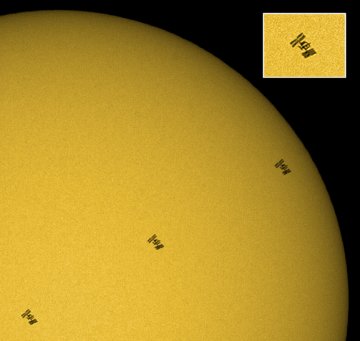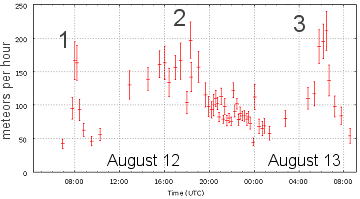| MORNING SHOW: If you wake up before sunrise this weekend, look east. The crescent Moon is approaching Venus for a Monday-morning close encounter. The International Space Station is likely to be there, too. So be alert for a gathering of bright lights in the dawn sky; it's a great way to start the day. Sky maps: Aug. 16th, 17th. SPACE STATION SILHOUETTE: The sun is blank--no sunspots. That makes it a perfect backdrop for passing spaceships: 
Amateur astronomer Levin Dieterle photographed the transit this morning, August 15th, from Hofstetten, Germany. "The ISS crossed the entire sun in only 0.64 seconds," he says. He captured the split-second event using a solar-filtered telescope and a Canon 40D digital camera. The station's silhouette traces solar arrays, science labs, living quarters and a docked Russian supply ship. Next year, the outline will expand to include a cosmic ray telescope called the Alpha Magnetic Spectrometer. From its perch atop the station's massive backbone, or "truss," the telescope will scan the heavens for antimatter galaxies, strangelets, dark matter and other exotic phenomena only detectable from Earth orbit. Get the full story from Science@NASA. PERSEIDS CUBED: Why was this year's Perseid meteor shower so good? Three reasons: 
According to the International Meteor Organization, the shower peaked an extraordinary three times. The first peak, around 0800 UT on August 12th, was caused by Earth hitting a filament of dust shed by Perseid parent Comet Swift-Tuttle in 1610. The second peak, around 1800 UT on August 12th, was another cloud of dust from Comet Swift-Tuttle nudged toward Earth by the gravity of Saturn. The third peak, around 0600 UT on August 13th, is a mystery. Researchers are working now to "reverse-forecast" the shower and figure out the source of the third outburst. Stay tuned for spectulation. 2009 Perseid Photo Gallery
[Science@NASA: The Perseids are Coming, Horse Flies and Meteors]
2009 Noctilucent Photo Gallery
[previous years: 2008, 2007, 2006, 2005, 2004, 2003]
July 2009 Aurora Gallery
[previous Julys: 2008, 2007, 2006, 2005, 2004, 2003]
Explore the Sunspot Cycle | 
